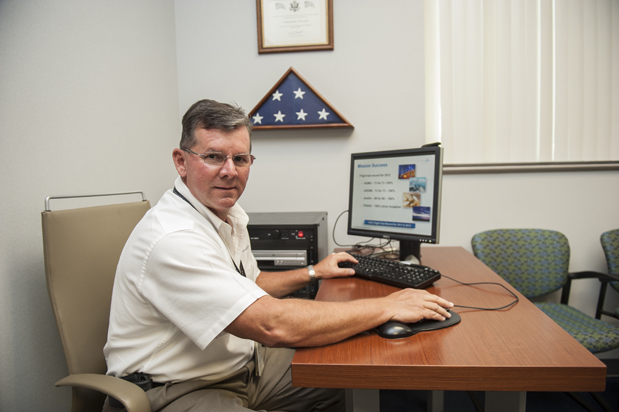With its rich history in space exploration and full-size replica of the Saturn V moon rocket seen for miles, Huntsville is practically synonymous with space technology. NASA’s largest center is located in Huntsville. And Huntsville’s U.S. Space & Rocket Center’s Space Camp is nearly as popular and well known as Disney World.
What’s not as well known is the city’s equally important role in missile defense. Huntsville first came in contact with missiles back in 1945 with a project that demonstrated the ability to produce liquid propellant. That’s almost four decades before President Ronald Reagan announced his plan to develop a space-based anti-missile system so sci-fi seeming that the press dubbed it “Star Wars.”
Once again, the nation’s missile defence program is ramping up with Huntsville as a key player. Currently, the United States has 30 ground-based interceptors in Alaska and California. Taking action against North Korea’s growing nuclear weapons and missiles threat, the Pentagon announced it will spend $1 billion to deploy an additional 14 ground-based interceptors to bases in Alaska, increasing missile defense capabilities by nearly 50 percent. The nation’s boost in missile defense also is in response to Iran’s large missile arsenal, acquired mainly from North Korea.
Richard Lehner, head of public affairs for the U.S. Department of Defense’s Missile Defense Agency, says missile defense has been a core program in the Huntsville area for more than 40 years. He calls Huntsville the “center of gravity” for the nation’s ballistic missile defense technology. MDA’s Huntsville location is the 38, 000-acre Redstone Arsenal, home to more than 60 federal agencies and the hub of the Army’s missile programs. The first U.S. ballistic missiles were developed at Redstone in the 1950s.
“In terms of strictly missile defense, no other state has such a large concentration of people directly or indirectly involved with missile defense development, testing and acquisition. All of MDA’s missile defense technology programs have a large presence in Huntsville, more so than any other MDA location.” MDA’s 5, 000-plus employees who work in Huntsville have developed, tested and acquired both ground and sea-based missile defense systems that are on alert around the world to provide short, medium and long-range missile defense.
A number of companies with sites in Alabama provide contractor support managed by the Missile Defense Agency. They also produce interceptor missiles that are then provided to the military services for global deployment and defensive operations.

|
Boeing, part of Alabama’s space and defense programs for more than 50 years, is one such company.
Last year, Boeing moved to Redstone Gateway near Redstone Arsenal to consolidate its several Huntsville locations. Huntsville is headquarters for Boeing’s Strategic Missile and Defense Systems and ground-based midcourse defense (GMD), the division’s largest program. GMD land-based missiles are used to intercept incoming ballistic missiles in the middle of their flight. Boeing’s SM&DS division also is developing several advanced missile defense systems and integrated missile solutions.
Boeing Vice President and Huntsville Site Executive Tony Jones says the reason for the new Huntsville location is to manage costs, as well as improve productivity and increase competitiveness for growth. “Currently, we have a number of business pursuits with U.S. and international customers that could result in additional manufacturing opportunities in our Huntsville facilities.” In addition to its new Redstone Gateway operation, Boeing also will keep open its JetPlex site near the Huntsville International Airport.
The Massachusetts-based Raytheon Co. also maintains a strong presence in Huntsville. In November 2012, the company opened its new Raytheon Redstone Missile Integration Facility, where its Standard Missile-3 and Standard Missile-6 interceptors are developed.

|
Kevin Byrnes, Raytheon’s vice president of Huntsville Operations, says the SM-3 is the only missile today that can be launched from a ship, blast into space and take out short to mid-range ballistic missiles. The SM-3 uses a non-explosive warhead — a concept often described as “hitting a bullet with a bullet.” Byrnes says both the United States and Japan deploy this weapon around the world today to counter any incoming threats from North Korea and Iran.
The SM-6 is the U.S. Navy’s latest air defense weapon. The SM-6’s ability to see threats “beyond the horizon” is revolutionary, Byrnes says, which makes it a game changer for the U.S. Navy and fleet defense. In 2015, the SM-6 will take on a new role defending against ballistic missile threats in their final phase of flight.
“These aren’t your average missiles, ” Byrnes observes. “The SM-3 and SM-6 are world-leading defense assets, and no other interceptors like them exist today.”
According to Byrnes, as part of a state agreement tied to its new missile integration facility, Raytheon plans to add 200 more jobs in Huntsville by the end of 2014.
Lockheed Martin also maintains a strong presence in Alabama, where about 300 employees work at its nearly 4, 000-acre Missiles and Fire Control Pike County Operations located about six miles northeast of Troy. Lockheed’s combat-proven Javelin shoulder-launched missile is assembled here. The Javelin is a one-person portable and consists of a missile, a reusable command launch unit and a disposable launch tube. The Pike County site also produces two other air-to-ground missile systems, the Terminal High Altitude Area Defense missile (THAAD), and the Joint Air-to-Surface Standoff missile (JASSM).
Dave Anderson, Pike County Operations site director for Lockheed Martin Missiles and Fire Control, says because of Lockheed’s balanced portfolio of domestic and international customers and contracts, it is able to maintain a consistent level of missile production in Pike County. Missiles and Fire Control recently received a $34 million contract to continue JASSM integration on the Finnish Air Force’s F-18, which will lead to additional JASSM orders at its Pike County plant.

|
Most of us don’t know much about missiles but one thing we do know: they aren’t cheap. According to Defense Industry Daily, through fiscal year 2012, about $36.5 billion has been spent on ground-based midcourse defense (GMD), and another $4.5 billion is planned between FY 2013-2017. Defense Industry Daily is an online trade publication dedicated to defense acquisition, with emphasis on the procurement of weapon programs, systems and their subsystems.
Cost-cutting initiatives are taking place in Huntsville. The U.S. Army Space and Missile Defense Command/Army Forces Strategic Command (SMDC) at Redstone Arsenal is saving the taxpayers money by using low-cost targets during missile defense testing. SMDC public affairs specialist Jason Cutshaw says these low-cost targets cut expenses from about $30 million each for high-end targets to about $4 million for SMDC’s Zombie targets, which use government-owned material components no longer operational and subject to demilitarization.
Cutshaw says the Zombie (named for its “rebirth” of dead components) provides a savings of 60 percent over previous target costs. The Lance is another SMDC low-cost target. At less than $500, 000 apiece, it’s a relative bargain in the multibillion-dollar missile defense budget.
Bryon Manley, chief of SMDC Technical Center Flight Test Services, says the objective is to develop new targets that use old rocket motors that the Army has already invested in that have no future use. “We are taking them and retrofitting and reconfiguring them to fly in a manner for which they were not designed. The SMDC Technical Center is at the forefront of providing the kind of missile defense testing capability to really save the Army a lot of money on its targets.”
Jessica Armstrong is a freelance writer for Business Alabama. She lives in Auburn.
Text by Jessica Armstrong



